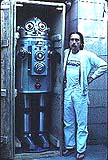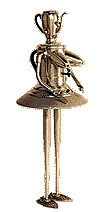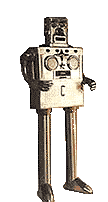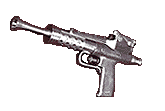
|
Recycling the Future: The Ray Gun and Robot Sculpture of Clayton Bailey Like many artists, sculptor Clayton Bailey has long been an admirer of space toys. Frequenting local swap meets and flea markets, he has amassed a large collection of robots and ray guns, which have, in the last two decades, significantly influenced his art. Although robot and ray gun sculpture is only a part of Bailey's body of work, it is an aspect of his creative output that has brought him international attention, and which highlights the remarkable aesthetic qualities of these sculptural toys. Bailey taught sculpture for many years at the University of Wisconsin and then at California State University at Hayward. His art has been presented in scores of solo and group exhibitions around the world and is to be found in many public and private collections. Robots
One of Bailey's best known robots is Marilyn Monrobot.Created in 1997 of reclaimed kitchenware, auto parts, baseball bats and other outworn materials, she is called by the artist "the world's most beautiful robot," and features hugh coffee pot breasts and blinking rubber nipples. Exhibited in a show at the Lawrence Hall of Science at the University of California, Berkeley, the sculpture created a scandal and was thrown out of the exhibition because of its sexual suggestiveness. Reported in newspapers ranging from the National Enquirer to the Los Angeles Times, this event caused a national uproar. According to Los Angeles Times art critic William Wilson, the statue was "estimably tasteless," although other critics found her to be humorous and sensual.
Yet Bailey's world of robots is filled with even more robot-like creatures. A large sculpture called Rocket Man sits on the roof above his house, and each night the artist lights its internal engine so that it can spew red exhaust flames into the night air. In addition, Bailey has made a Robot Teapot of porcelain which, he claims, brews a perfect pot of tea, as well as a Robot Light Switch..
Ray Guns Bailey began making sculptural ray guns in 1996, and like his robots, these sculptures were fashioned primarily from found materials. In Bailey's hands, old bicycle parts, broken electric drills, discarded ski poles and rusty faucet handles are transformed into sleek and fanciful futuristic-looking firearms. The most remarkable thing about Bailey's ray gun sculpture is that it transforms still recognizable objects of the mundane and everyday world into new and fantastic creations. Bailey's ray gun sculpture includes:
In recent years, Bailey has made working ray guns, most of which shoot corks and bits of potato. Bailey prefers these to his early, nonfunctional guns because they are more fun to play with. Like his earlier ray guns, the cork and potato shooting ray guns are also made primarily of found materials. Some of these guns include: Cork Shooting Ray Guns Potato Shooting Ray Guns Each of Clayton Bailey's ray guns is created individually, and all are signed and numbered by the artist. To see more of Bailey's art and to ask about prices, visit his website or email him..
|

 Clayton Bailey made his first robot in 1976. Called
Clayton Bailey made his first robot in 1976. Called ing about six feet tall and incorporating old radios, juke boxes and various working dials and gizmos, these sculptures satirize the technology that created them.
ing about six feet tall and incorporating old radios, juke boxes and various working dials and gizmos, these sculptures satirize the technology that created them. The same year Bailey made Marilyn, he also created
The same year Bailey made Marilyn, he also created 

